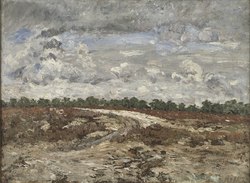Carl Fredrik Hill
This article includes a list of general references, but it lacks sufficient corresponding inline citations. (March 2013) |


Carl Fredrik Hill (31 May 1849 – 22 February 1911) was a Swedish painter and draftsman.[1] He is known for the atmospheric landscapes he painted during the first four years of his career, and for the drawings of fantastical scenes he created after he became mentally ill in his late twenties.
Biography
Early life and training
Born the son of a mathematics professor, Hill grew up in the university town of
Career



Hill wrote: “I have become convinced that art has no other goal than the truth, le vrai. Not the tritely naturalistic, but the true heart." He sought his subjects at different sites in France;
Later period
During the 28 years before his death, Hill's creative work entered a new phase. The Swedish art historian Ragnar Josephson calls it "the second great period of his life as a painter". His artistry continued unabated; during these years he drew four drawings a day. The
Hill never lived to see his recognition as an artist. He produced thousands of drawings in various techniques:
Hill's drawings were discovered and admired mainly by artists. Thanks to the Swedish collector Rolf de Maré (1888–1964), Hill's work become known in connection with the French avant-garde of the 1920s and 1930s. In 1949, a hundred years after Hill's birth, a travelling exhibition was shown in London, Lucerne, Basel, Geneva and Hamburg. The exhibition was a success, and in 1952 the Institut Tessin in Paris published a book about Hill with an introduction by Jacques Lassaigne. Since then several works about Hill have appeared in Sweden, and Hill exhibitions succeed one another both in Sweden and abroad. Hill is now reckoned as one of Sweden's most important landscape painters, and the drawings done during the time he was ill in Lund have made him known outside Sweden as well.[5]
Selected works
- The Cemetery (1877) Malmö Art Museum
- Quarry with wheel tracks (1877) Malmö Art Museum
- untitled (crying dear) (1883–1911) Malmö Art Museum
- untitled (landscape) (1883–1911) Malmö Art Museum
- untitled (female with demons) (1883–1911) Malmö Art Museum
- untitled (found by the Good Samaritan) (1883–1911) Malmö Art Museum

References
- ^ a b c Svenskt biografiskt lexikon. "Carl Fredrik Hill". Nils Lindhagen. Retrieved March 1, 2019.
- ^ a b c d Gunnarsson, T. (2003, January 01). "Hill, Carl Fredrik". Grove Art Online.
- ^ "Carl Fredrik Hill (1849-1911) Sweden". barnebys.com. Retrieved March 1, 2019.
- ^ Roberta Smith (November 19, 2009). "Carl Fredrik Hill (1849-1911) Sweden". Art in Review. Retrieved March 1, 2019.
- ^ "Rolf de Maré – rik, gay och framsynt danspionjär". Sveriges Radio AB. Retrieved March 1, 2019.
Other sources
![]() Media related to Carl Fredrik Hill at Wikimedia Commons
Media related to Carl Fredrik Hill at Wikimedia Commons
- Lindhagen, Nils (1976). Carl Fredrik Hill Sjukdomsteckningarna. (Malmö: Bernces förlag). ISBN 91-500-0274-0
- Rosdal, Anders. (2003). Hill målar (Malmö: Malmö Art Museum) ISBN 91-87336-67-7
- Christenson, Göran (2000). Carl Fredrik Hill. (Malmö: Malmö Art Museum). ISBN 91-630-9979-9
